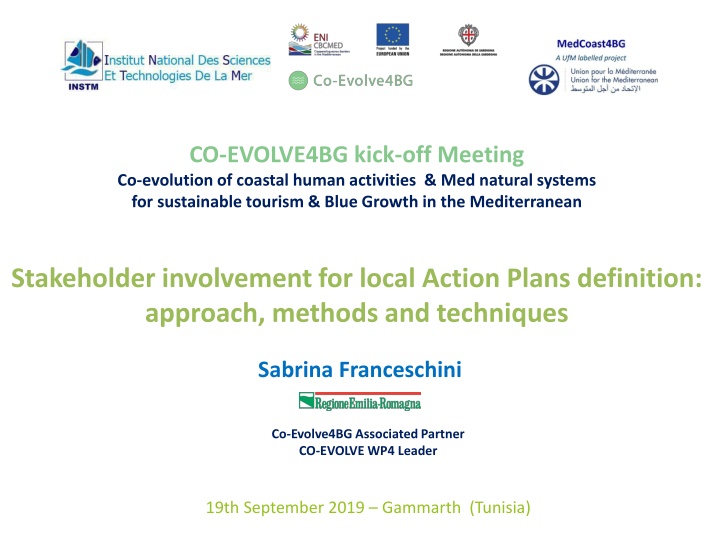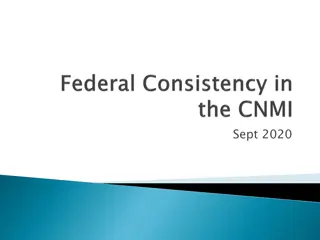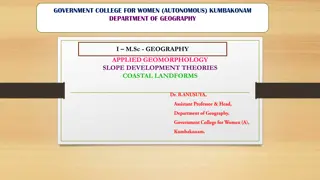Co-evolution of Coastal Human Activities and Mediterranean Natural Systems for Sustainable Tourism
The kick-off meeting focused on the co-evolution of coastal human activities and Mediterranean natural systems for sustainable tourism in the Mediterranean region. Stakeholder involvement in developing local action plans was emphasized through participatory processes, aiming to address real needs and promote collaboration, informed decision-making, and conflict resolution. The importance of engaging various subjects and managing conflicts in participatory processes was highlighted for effective policy development.
Download Presentation

Please find below an Image/Link to download the presentation.
The content on the website is provided AS IS for your information and personal use only. It may not be sold, licensed, or shared on other websites without obtaining consent from the author.If you encounter any issues during the download, it is possible that the publisher has removed the file from their server.
You are allowed to download the files provided on this website for personal or commercial use, subject to the condition that they are used lawfully. All files are the property of their respective owners.
The content on the website is provided AS IS for your information and personal use only. It may not be sold, licensed, or shared on other websites without obtaining consent from the author.
E N D
Presentation Transcript
CO-EVOLVE4BG kick-off Meeting Co-evolution of coastal human activities & Med natural systems for sustainable tourism & Blue Growth in the Mediterranean Stakeholder involvement for local Action Plans definition: approach, methods and techniques Sabrina Franceschini Co-Evolve4BG Associated Partner CO-EVOLVE WP4 Leader 19th September 2019 Gammarth (Tunisia) 1
Definition A participatory process is a way to involve citizens, stakeholders, and communities in defining plans and taking decisions that affect them, making it easier to implement since they are defined together. The process must always "be linked" to a well-identified need Participation works have to represents the answer to a real need / problem there is no pre-established or 'pre-packaged' solution to resolve the issue there should be a genuine willingness to open up to dialogue on the object identified.
Why To achieve more information and elements about the decision from the actors involved To make more viable the implementation of decision because the point was discussed before To prevent or deal with conflicts in advance To get the collaboration of community for the co-produced policies To make more informed and responsible the citizens and stakeholders 3
When A) When the contribution of other subjects is required: In the case of co-produced Policy: it is necessary that the recipients of a specific policy, in addition to putting their different points of view and interests on the table, are actually involved in the implementation of the process; also contributing effectively to the solution of the problems. In the absence of cognitive elements: in cases where you do not have certain cognitive resources, or you only have partial information and to proceed, it is necessary to involve other (technical) subjects able to integrate them with their contribution. 4
B) In the presence of conflict: Conflicts related to the theme (to the object, or to the context) concerning the participatory process can be managed according to two distinct models. 1. To avoid interferences that could compromise the work, which is thus carried out with discretion. However, this choice often ends up by exacerbating the conflict 2. On the contrary, provoke in advance the reactions of the stakeholders and potential opponents through an early communication, which arouses interest around the project can induce them to think about the problem, and not only on a specific solution, and then push them to engage in the formulation of new and innovative ideas and proposals. 5
Benefit A participatory process can: improve the quality of public policies, closer to the real needs of all those involved, thanks to their ideas and suggestions; empowering and motivating citizens, and local actors/stakeholders, in implementing the choices taken collectively; activate processes of active citizenship able to strengthen social cohesion and a sense of belonging; managing and reducing conflicts, increasing trust in institutions and countering the lack of legitimacy and consensus; increase the level of transparency and openness of the work of the administration that promotes it. 6
Phase of the policy and participations level At the start of a participatory process it is necessary that the Administration establishes explicitly the objectives and conditions within which the process takes place, make a real "Participatory Deal" with the subjects involved: in order to avoid misunderstandings and disappointments from them. A process of participation must fit properly within the institutional process envisaged by the public policy of reference. Level Description The promoter of the process provides information on a project (or a policy) implemented or which it intends to carry out. All decisions have already been made. The promoter of the process asks for feedback from the participants on a project (or a policy) that it intends to carry out. In this way they have the limited opportunity to influence certain aspects of the decision. INFORMATION CONSULTATION The process promoter analyzes problems, defines strategies and designs solutions together with the participants. Decisions are made on the basis of the skills, resources and responsibilities of both the promoter and participant bodies, or in partnership. The participants are able to autonomously manage proposals and projects on which they are looking for a confrontation with the public body: they are an active part of the decision-making process. PARTICIPATED DESIGN EMPOWERMENT 7
Phase of the policy and participations level LEVEL OF INVOLVEMENT INFORMATION In Co-Evolve WP4, the participation level for the definition of local action plans, tools and measures for sustainable tourism development in the pilot areas, was to be as participateddesign (or even empowerment ). basis/preliminary document , as defined, mainly represents -and should be clearly presented as- a first input to stimulate reactions, ideas and proposals by the participants. CONSULTATION The PARTICIPATED DESIGN EMPOWERMENT 8
Six Methodology Steps 1. 2. 3. 4. 5. 6. Context analysis Stakeholder involvement and partnership building Plan of activities Set up of tools Plan implementation and monitoring Evaluation 9
1. Context analysis The aims is to reach information about the social context for better design the process and involved the target. The analysis could include: socio-demographic, cultural and economic profile of the community which highlights the resources present, with the aim of identifying suitable ways to involve citizens and stakeholders preview similar experience in the same field (participation) or policy also by other subjects description of strength and weakness present in the community or in the organization in which the process takes place (both in terms of qualified personnel, and in regulatory and legislative terms).
2. Stakeholder involvement and partnership building Potentially all people could give useful contribution to our process But we have some formal methods for selected them: The dooropen : in this case we promote the workshops and the people choose if the events are of their interest or not. This method is also called auto-selection . The stakeholder map : as says the name, we decide who to invite beside the selection work. The map must include all the actors who will be have potential effect by the decision discussed during the process. The randomsample : this procedure is represented by the random selection of a sample of the reference population, which can be non- stratified or stratified on the grounds of specific social and demographic characteristics 11
Working group When several stakeholders, even belonging to different organizations, are involved in the process management, it could be useful to set up and formalize a working group whose main objective is to share the definition of strategies and organizational / management methods of the participatory process. The Working Group (or control room) includes all parties operationally involved in the management of the various phases of the participatory process, such as the person in charge of the process manager, one or more coordinators and officials and technicians belonging to the various entities involved . The presence of different points of view enriches and helps to create synergies but the responsibilities must be clearly defined : "who does what." 12
3. Plan of activities The participation process is like a project, so for the plan we propose the classical project management scheme. Description Indicators Verification's sources Aims Expected resultes Activities to achieve 13
Defining objectives and activities of the participatory process Defining the objectives to be achieved, or the purposes to be pursued by the participatory process, is a complex and never dull operation. To facilitate this task, it may be worthwhile to refer to the "SMART objective" concept developed as part of project management. Each objective identified for the process must be: Specific: it should be formulated in a clear and well detailed manner Measurable: It must be possible to identify an appropriate criterion for measuring Accessible: the goal must be actually feasible Relevant: it must be consistent with the mission Temporally defined: the time within which the target must be reached must be clearly established. 14
To carry out this activity for each identified objective, it is necessary to establish: expected results (i.e. tangible and intangible changes and / or improvements, consistent with the objectives, expected both in the short and long term from the participatory process); activities to be carried (i.e. the main actions to be undertaken to achieve the expected results). Measurement indicators are defined respectively for the targets, the expected results and the activities, as well as the related sources of verification used for gathering data and information for measurement purposes. 15
4. Set up of tools Based on the specificity of the process, you must decide how to articulate the steps online and offline, what tools and techniques to be used, the number of meetings, work methods, the time required and whether or not to use external or internal moderators / facilitators, if available. In general: It s always recommended to use an integrated approach in term of channels: traditional and new media have to be use both. The external support, in particular for workshops facilitation, it is important for professional aspect but also for role of moderator and guarantee. The internal team have to be prepared trough specific training. 16
5. Plan implementation and monitoring This phase is the core of the process. We have to implement the action plan and to tackle the possible deviation. In general the points of attention are: Check the list of stakeholders to invite; To activate in time the internal and/or external resources; To organize the (eventual) workshops locations and pay attention to the logistic aspect; Use all channels, traditional and digitals, to promote the process; Collect the data expected for monitoring the process indicators. 17
Monitoring the participatory process Monitoring consists of a systematic activity of collecting data and information on the progress made in the process. More specifically, using the verification indicators and the sources identified above the following items can be analyzed: the achievement of expected (short-term or partial) results any criticality and unexpected elements opportunities, both external or internal ones in the process All information collected at this stage, once processed by the working group and translated into appropriate corrective actions to be implemented, will be functional to any strategic and operational adaptations. 18
6. Evaluation Two reasons for evaluate: To measure the real impact of the process in relation to the aims in the context. To measure in term of benchmarking in relation to another similar project. Two dimensions for evaluation: The process (some indicators: inclusion, transparency, structure and methods, resources); The results/outcomes (some indicators: output, impacts, consequence for the participants). 19
Indicators For the process, the verification parameters are those listed below: Inclusion of all the points of view on the object under discussion. Transparent communication Use of methodological techniques and tools tailored . As regards, finally, the resources to draw on for the process, it is necessary to take into account the total cost / number of participants; and of the total cost of the process / n ideas or proposals emerged. For the outcomes: Output: formalization in a document of ideas and heterogeneous contributions collected during the comparison with the participants. Effects on participants: satisfaction with personal experience; satisfaction with the process and the outcome; Impact: what impact the participatory path has had on the decision / policy. 20
Challenges and solutions Challenge Solution New orchestration capability needs to be developed Team building and Action Planning Feedback mechanisms and participation are essential ingredients to developed effective policies Stakeholder engagement with innovative mechanisms Discuss about technical problems and themes with citizens and local communities (non expert stakeholders) New language approach and new perspective Institutions and Local Authorities go face to face with public: communication and participation is a risk? Public participation in decision making Clarify public role and competences in a transparent and smart modality. 21
Tips to share Tip 1 Tip 2 Do not be discouraged by the (normal) difficulty: every problem is a challenge to overcome Taking the time to process design and internal sharing tips Tip 4 Do not be afraid to do things they have never done innovation goes from there! Tip 3 Participation is a hard task for citizens but can be extremely interesting: dedicate your time in these initiatives!! 22
THANKS YOU FOR YOUR ATTENTION! Name: Sabrina Franceschini Email: sabrina.franceschini@regione.emilia-romagna.it Web site of the partner: www.regione.emilia-romagna.it/ E-part platform: http://partecipazione.regione.emilia-romagna.it/iopartecipo Twitter: @iopartecipoplus Facebook: @IoPartecipo 23























